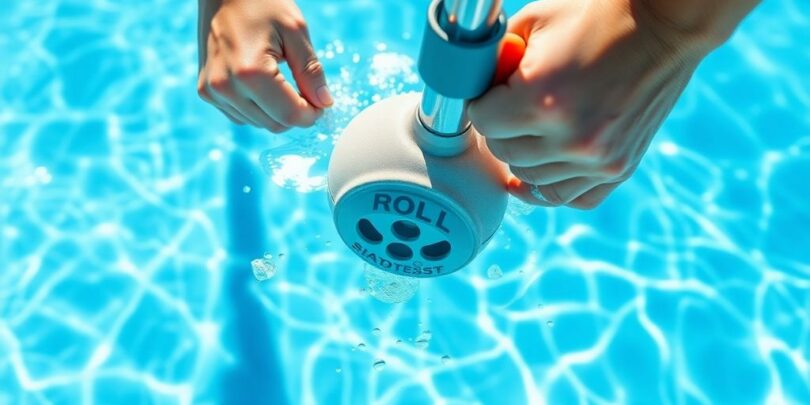G’day, fellow pool owners! If you’re keen to keep your backyard oasis sparkling clean without too much fuss, you’ve come to the right place. We’re gonna chat about how to clean your pool with a manual pool vacuum, just like a true blue Aussie. It’s not as hard as you might think, and once you get the hang of it, you’ll be wondering why you didn’t start sooner. Let’s get stuck in and make that pool shine!
Key Takeaways
- Regularly cleaning your pool with a manual pool vacuum keeps it sparkling.
- Pick the right manual pool vacuum head for your pool type.
- Prep your pool properly before you start vacuuming.
- Use slow, steady strokes for the best clean with your manual pool vacuum.
- Always look after your manual pool vacuum gear after each use.
Why A Manual Pool Vacuum Is Your Best Mate
Simple And Efficient Cleaning
Using a manual pool vacuum gives you direct control, letting you target those tricky spots where leaves and debris love to hang out. It’s a straightforward way to get your pool looking schmick without too much fuss. You just hook it up and get going, sucking up all the bits and pieces that have settled on the bottom. It’s a bit like using a regular vacuum cleaner inside, but for your pool. Plus, you don’t have to worry about complicated programming or sensors playing up. It’s a reliable way to maintain your pool vacuum cleaner.
Built To Last For Aussie Conditions
Our Aussie weather can be pretty harsh, right? Blazing sun, sudden downpours, and all sorts of debris finding its way into your pool. Manual pool vacuums are generally built tough, designed to withstand the elements and keep on going. They don’t have fancy electronic components that can fail in the heat or after a bit of rain. They’re simple, robust, and ready to tackle whatever your pool throws at them. Plus, they connect easily to your standard pool gear.
Cost-Effective Pool Care
Let’s be honest, pool ownership can be a bit pricey. But a manual pool vacuum is a budget-friendly option that gets the job done. You don’t need to fork out a fortune for fancy automatic cleaners or worry about ongoing electricity costs. A manual vacuum is a one-off investment that will keep your pool sparkling for years to come, provided you look after it. It’s a great way to save some dosh while still enjoying a clean and inviting pool. It’s a simple way to ensure cost-effective pool care.
Regular vacuuming helps your pool by reducing the organic load, maintaining chemical balance, extending philtre life, preventing algae growth, and enhancing clarity. Ultimately, you get clearer, healthier water that’s a joy to swim in. It’s all about keeping things clean from the ground up.
Choosing The Right Manual Pool Vacuum Head
Alright, so you’re ready to get your pool sparkling, eh? Choosing the right manual pool vacuum head is like picking the right thongs for the beach – get it wrong, and you’re gonna have a bad time. A good vacuum head will make cleaning a breeze. Let’s dive into what you need to consider.
Understanding Different Vacuum Head Types
There’s a few different types of vacuum heads out there, each designed for a specific purpose. You’ve got your standard rectangular heads, flexible heads, and triangular heads. Rectangular heads are your all-rounders, good for most pools. Flexible heads are great for getting into those awkward corners and curves. Triangular heads are designed to get right into the edges and tight spots. Knowing your pool’s shape and surface will help you pick the right one. For example, if you have a telescopic pole, make sure the head is compatible.
Matching The Head To Your Pool Surface
This is where things get important. You wouldn’t use a scrubbing brush on a delicate surface, would ya? Same goes for your pool. If you’ve got a vinyl liner pool, you’ll want a vacuum head with soft bristles or a smooth surface to avoid tearing or scratching the liner. For concrete or fibreglass pools, you can go for something a bit more robust, like a flexible head that can handle the rougher surface. Here’s a quick guide:
- Vinyl Liner Pools: Use a vacuum head with soft bristles and a weighted design to prevent lifting the liner.
- Fibreglass Pools: A flexible head is ideal for navigating curves and corners without scratching the surface.
- Concrete Pools: A sturdy, wheeled vacuum head can handle the rough surface and heavy debris.
Considering Durability For Aussie Summers
Let’s face it, Aussie summers are brutal. The sun, the heat, the chemicals – it all takes a toll on your pool equipment. That’s why durability is key when choosing a vacuum head. Look for models made from UV-resistant and chemical-resistant materials. You don’t want something that’s going to crack or [pool cleaners] fade after a few months in the sun. Check for things like reinforced plastic or sturdy construction. It might cost a bit more upfront, but it’ll save you money in the long run.
Getting a durable vacuum head is a smart investment. It’ll withstand the harsh Aussie climate and pool chemicals, saving you from frequent replacements. Look for UV-resistant and chemical-resistant materials to ensure longevity.
Prepping Your Pool For A Pristine Clean

Before you even think about chucking that vacuum in, there’s a bit of prep work to do. Think of it like getting the snag station ready before a barbie – a little effort now saves a whole lot of grief later. Getting everything sorted before you start vacuuming is key to a smooth, effective clean.
Gathering Your Manual Pool Vacuum Gear
Right, first things first, round up all your gear. You don’t want to be halfway through and realise you’ve left your pole on the other side of the yard. Here’s what you’ll need:
- Your trusty pool vacuum head (the one you picked out earlier, remember?)
- A telescopic pole, long enough to reach every nook and cranny
- Your pool hose – make sure it’s free of kinks and holes
- A skimmer box vacuum plate (if you’re using one)
- A pool brush, for those stubborn bits
It’s a bit like getting ready for a road trip; you wouldn’t just jump in the car without checking the fuel and tyres, would ya? Same goes for pool cleaning. A quick check of your kit means no mid-job dramas.
Checking Your Pool’s Water Level
This one’s a ripper. Before you start, have a squiz at your pool’s water level. It needs to be high enough for the skimmer to work properly while you’re vacuuming. If it’s too low, you’ll end up sucking air into the system, which can cause all sorts of dramas with your pump. Top it up with the hose if needed. A good water level ensures efficient cleaning and prevents damage to your equipment.
Brushing Down The Pool Walls
Give those pool walls a good scrub with your pool brush before you start vacuuming. This loosens up any algae or grime that’s clinging on, making it easier for the vacuum to suck it all up. Pay special attention to the corners and steps, as these are prime spots for buildup. Brushing before vacuuming is like sweeping before mopping – it just makes the whole job easier and more effective. It also helps to prevent algae bloom later on.
Mastering The Manual Pool Vacuuming Technique
Right, so you’ve got all your gear ready to go. Now for the main event. Getting the vacuuming right isn’t rocket science, but there’s a certain way to do it if you want a pool that’s properly clean and not just… sort of clean. It takes a bit of practise, but you’ll get the hang of it.
Slow And Steady Wins The Race
You might be tempted to rush through it, but that’s the worst thing you can do. If you move the vacuum head too quickly, you’ll just push the dirt around and make the water cloudy. Then you have to wait for it all to settle again. The real trick is to move the vacuum head slowly enough that it sucks up the gunk without making a cloud in the water. It feels a bit like you’re moving in slow motion, but trust me, it’s worth it.
Think of it like a slow dance with your pool. You want smooth, deliberate movements that give the suction time to do its job properly. Rushing just makes a bigger mess for you to clean up later.
Overlapping Your Strokes For Full Coverage
To make sure you don’t leave any annoying lines of dirt behind, you’ve got to overlap your passes. It’s just like mowing the lawn. You want to cover every single bit of the pool floor. A systematic approach is your best bet here, and these same ideas apply even when vacuuming an above-ground pool.
- Start at the shallow end and make your way to the deep end.
- Move in straight lines, either horizontally or vertically across the pool.
- Overlap each new pass by about one-third of the vacuum head’s width.
- Don’t forget the corners and around the steps, as that’s where dirt loves to hide.
Tackling Stubborn Spots With Your Manual Pool Vacuum
Every now and then, you’ll hit a patch of gunk that doesn’t want to move. It could be a clump of algae or some fine, heavy silt. Don’t get frustrated. Just go over the spot a few more times, keeping your movements slow. For really difficult bits, a little extra downward pressure can help, but don’t go crazy and risk scratching your pool surface.
Here’s a quick look at how to handle different messes:
| Debris Type | How to Handle It |
|---|---|
| Fine Silt/Sand | Use very slow movements. Rushing will kick it up immediately. |
| Leaves & Twigs | Go over them slowly; the vacuum should pick them up easily. |
| Algae Patches | Brush the spot first, then vacuum the loosened particles slowly. |
Post-Vacuum Care For Your Pool And Equipment
Alright, you’ve finished vacuuming the pool. Good on ya! But don’t chuck your feet up just yet. There are a few things you need to do after vacuuming to keep your pool sparkling and your gear in tip-top shape. Think of it as the cool-down lap after a hard workout.
Backwashing Your Philtre After Vacuuming
After vacuuming, especially if your pool was looking a bit rough, your philtre has probably collected a fair bit of muck. Backwashing your philtre is essential to remove all that trapped debris. It’s a pretty simple process, but it makes a huge difference to your philtre’s performance and the overall cleanliness of your pool. Here’s a quick rundown:
- Turn off your pump.
- Set your multiport valve to the ‘Backwash’ setting.
- Turn the pump back on and let it run for about 2-3 minutes, or until the water in the sight glass runs clear.
- Turn off the pump again and set the valve to ‘Rinse’ for about 30 seconds to settle the sand bed.
- Finally, turn off the pump and return the valve to the ‘Philtre’ setting.
Backwashing regularly prevents your philtre from becoming clogged, which can reduce its efficiency and even damage the pump. It’s a small effort that can save you a lot of hassle in the long run.
Checking Your Pool’s Water Chemistry
Vacuuming can stir up all sorts of things in your pool water, so it’s a good idea to check your water chemistry afterwards. Grab your good test kit and test the pH, chlorine, and alkalinity levels. Here’s a quick guide:
- pH: Should be between 7.2 and 7.8.
- Chlorine: Aim for 1-3 ppm (parts per million).
- Alkalinity: Keep it between 80 and 120 ppm.
If anything’s out of whack, add the appropriate chemicals according to the instructions. Balanced water chemistry not only keeps your pool sparkling but also protects your equipment and keeps swimmers safe. You might need to add some pool cleaning equipment if things are really out of balance.
Cleaning And Storing Your Manual Pool Vacuum Gear
Don’t just chuck your vacuum head and hose back in the shed! Give them a good rinse with the hose to get rid of any lingering dirt or chemicals. Let them dry completely before storing them in a cool, dry place. This will help prevent mould and mildew and keep your gear in good nick for longer. Also, coil the hose loosely to avoid kinks and cracks. A little bit of care goes a long way in extending the life of your pool vacuum head. The Aussie sun can be brutal, so storing your gear in the shade is a must. UV rays can damage the plastic and rubber components, shortening their lifespan. Find a cool, dry spot, away from direct sunlight, to store your vacuum head, hose, and pole. This will help keep them in good condition for many summers to come. Summertime Pools offers swimming pool cleaners designed for easy storage, so consider those when you’re upgrading your gear.
Troubleshooting Common Manual Pool Vacuum Issues

Dealing With Loss Of Suction
Right, so your manual pool vacuum’s lost its mojo and isn’t sucking up the crud like it should? First things first, check all the connections. Is the hose properly connected to the skimmer or vacuum line? Make sure it’s snug. Air leaks are the usual suspects here. Have a good look at the hose itself – any cracks or splits? Even a tiny hole can kill your suction. If the hose is looking worse for wear, it might be time for a new one. Also, give your skimmer basket and pump basket a good clean. If they’re chockers with leaves and debris, it’ll restrict the water flow and reduce suction.
Preventing Cloudy Water After Vacuuming
Nobody wants a pool that looks like a milky lagoon after vacuuming. The key here is to vacuum slowly and steadily. Rushing the job stirs up all the fine particles, making the water cloudy. Make sure your philtre is up to scratch. If it’s old or clogged, it won’t be able to catch those fine particles. A good backwash after vacuuming is essential to clear out any gunk that’s built up in the philtre. You might also consider using a philtre clarifier to help the philtre trap those really small particles.
Addressing Algae Bloom Challenges
Algae blooms can be a real pain in the backside, turning your pool into a green swamp. Vacuuming up algae is important, but it’s only part of the solution. You’ll need to kill the algae first with a good shock treatment.
Once the algae is dead (it’ll usually turn a greyish-white colour), then you can vacuum it up. Be prepared to backwash your philtre frequently during and after vacuuming, as it’ll get clogged up pretty quickly. For serious algae problems, you might even consider using a philtre sock or vacuuming to waste to avoid overloading your philtre. And of course, make sure your pool water chemistry is spot on to prevent future blooms.
Dealing with algae is a multi-pronged attack. Vacuuming removes the dead algae, but you also need to address the underlying cause – usually an imbalance in your water chemistry or poor circulation. Regular testing and maintenance are key to keeping those pesky algae at bay.
Here’s a quick checklist for dealing with algae:
- Test and balance your water chemistry (pH, alkalinity, chlorine).
- Shock the pool to kill the algae.
- Vacuum up the dead algae.
- Backwash your philtre.
- Run your philtre continuously for 24-48 hours.
Integrating Manual Vacuuming Into Your Pool Routine
Establishing A Regular Cleaning Schedule
Right, so you wanna keep your pool lookin’ bonza, yeah? Well, sticking to a regular cleaning schedule is the key. Don’t just wait ’til it looks like a swamp after a bushfire. Think about vacuuming at least once a week, maybe more if you’ve got heaps of trees around or the kids are using it heaps.
- Weekly: Standard clean to remove settled debris.
- Bi-weekly: If the pool sees light use and minimal debris.
- After storms: Essential to clear out leaves and dirt blown in.
A good rule of thumb is to check the pool every few days and give it a quick vacuum if you see any build-up of leaves or sediment. It’s easier to manage little bits often than to tackle a massive clean-up later. Plus, your pool gear will thank you for it.
Complementing Automatic Cleaners With Your Manual Pool Vacuum
Got one of those fancy automatic pool cleaners? Good on ya! They’re grouse for keeping on top of things, but they’re not perfect. Think of your manual vacuum as the back-up mate. Use it to get into those tricky spots the automatic cleaner misses, like the steps, corners, or around the skimmer box. A pool maintenance routine that combines both is the best way to go.
Seasonal Manual Pool Vacuuming Tips
Seasons change, and so should your pool cleaning routine. Here’s the lowdown:
- Summer: Vacuum more often due to increased use and sunscreen build-up.
- Autumn: Get ready to vacuum leaves every other day. Seriously, they’ll be everywhere.
- Winter: Reduce vacuuming frequency as the pool is used less, but don’t neglect it completely. Algae can still grow, even when it’s cold.
- Spring: Time for a proper deep clean after winter. Get rid of all the accumulated grime and get your pool ready for summer. Consider using a pool vacuum cleaner for a thorough clean.
Wrapping It Up: Your Pool, Sparkling Clean!
So, there you have it, folks! Getting your pool sparkling clean with a manual vacuum isn’t some big secret. It’s just about knowing a few simple steps and having the right gear. You don’t need to be a pool expert to get it done. Just take your time, follow these tips, and you’ll have a pool that’s ready for a swim, no worries. It’s all about keeping things simple and getting the job done right, so you can spend more time enjoying your backyard oasis and less time scrubbing. Happy swimming!
Frequently Asked Questions
Why should I bother vacuuming my pool?
Using a manual pool vacuum is a top-notch way to keep your pool sparkling clean. It’s super simple to use, does a fantastic job of getting rid of all sorts of muck, and helps keep your water healthy so you don’t need as many chemicals. Plus, our vacuum heads are built tough for the Aussie climate, meaning they’ll last for ages.
What kind of pool vacuum head should I get?
You’ve got a couple of excellent choices! The ‘True Blue’ vinyl liner vacuum head is perfect for vinyl pools, but it also works a treat on concrete and fibreglass. It’s got brushes to scrub away dirt. Then there’s the ‘Aussie Gold’ flexible vacuum head, which is ace for all pool types, from concrete to tiled. Both are built tough and connect easily to your standard pool gear.
What should I do before I start vacuuming?
Before you get stuck into vacuuming, gather all your bits and pieces: your vacuum head, a long pole, your hose (make sure it’s not kinked!), a skimmer box vacuum plate if you use one, and a pool brush. Also, check your pool’s water level – it needs to be just right. Then, give the pool walls and floor a good scrub to loosen any dirt before you vacuum.
What’s the best way to vacuum my pool?
The main thing is to go slow and steady. If you rush, you’ll just stir up all the dirt and make the water cloudy. Move the vacuum head smoothly across the bottom, overlapping each pass a little bit so you don’t miss any spots. Think of it like mowing the lawn – nice, even rows.
What should I do after I’ve vacuumed my pool?
Once you’re done, give your philtre a good backwash to get rid of all the crud you’ve sucked up. Then, it’s a good idea to check your pool’s water chemistry to make sure everything’s balanced. If your water looks a bit cloudy, don’t stress – it usually means your philtre needs a clean, so sort that out quick smart.
How do I look after my pool vacuum equipment?
To keep your gear in top nick, always give your vacuum head and hose a good rinse with fresh water after each use. Store them somewhere shady, out of the harsh Aussie sun, so they don’t get brittle or fade. Looking after your equipment means it’ll last longer and work better next time you need it.








